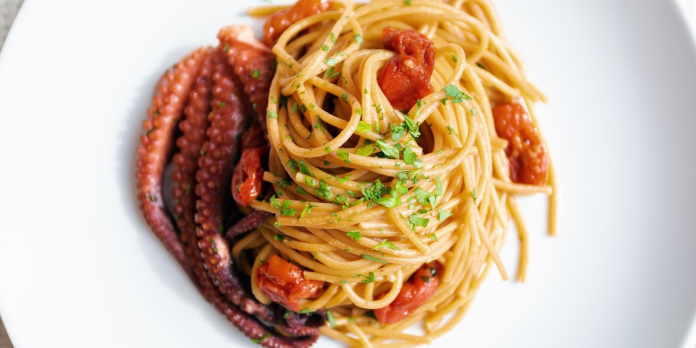Table of Contents
Pasta, an Italian culinary masterpiece, has transcended cultural boundaries to become a household staple globally. Praised for its versatility and delectable taste, it has faced scrutiny concerning its impact on health. However, when approached with mindfulness in preparation and consumption, it emerges as a worthy addition to a wholesome diet. In this article, we delve into the health benefits of it, shedding light on why this beloved dish deserves a prominent place on your plate.
In the timeless saga of culinary exploration, few gastronomic wonders captivate the senses and tantalize the taste buds quite like pasta. As we navigate the intricate landscape of dietary discourse, pasta emerges not merely as a culinary delight but as a veritable emblem of nutritional enlightenment, boasting a tapestry of health benefits that unfurl like a savory symphony on the palate. In the annals of gastronomy, 2023 stands as a pivotal chapter, wherein the multifaceted virtues of pasta are illuminated with newfound fervor and scientific scrutiny.
The humble origins of belie its profound impact on global cuisine and human health. From the sun-drenched shores of Italy to the bustling streets of Asia, pasta transcends cultural divides, weaving a culinary thread that binds nations and generations. Yet, amidst its culinary ubiquity, pasta’s nutritional prowess often languishes in the shadows of misconceptions and dietary dogma.
In the wake of a burgeoning wellness movement, 2023 emerges as a watershed moment, wherein pasta emerges from the culinary crucible, reborn as a beacon of healthful living. No longer confined to the realms of indulgence or guilt-laden indulgence, pasta emerges as a veritable elixir of vitality, offering a symphony of nutrients that nourish the body and invigorate the spirit.
As we embark on this epicurean odyssey, our journey is guided by a singular question: What secrets lie within the labyrinthine coils of pasta, waiting to be unearthed by the discerning epicurean? In our quest for culinary enlightenment, we peel back the layers of pasta’s nutritional mystique, revealing a treasure trove of health benefits that defy conventional wisdom and ignite a culinary revolution.
Prepare to embark on a gastronomic voyage like no other as we traverse the vast expanse of pasta’s nutritional landscape, uncovering hidden gems of wellness wisdom and savoring each moment with the gusto of a true epicurean. From its humble origins to its lofty status as a nutritional powerhouse, pasta beckons us to indulge in its myriad delights and embrace a lifestyle of healthful hedonism.
So, dear epicurean traveler, cast aside your preconceptions and join us on a journey of culinary enlightenment as we explore the great health benefits of a good pasta in the bountiful year of 2023.
Nutrient-Dense Foundation

Predominantly crafted from durum wheat semolina or whole wheat flour, serves as a nutrient-rich base for various dishes. It offers a rich source of complex carbohydrates, ensuring a gradual release of energy, making it an ideal choice for athletes and those leading active lifestyles. Additionally, it contains essential nutrients such as B-vitamins, iron, and magnesium, contributing significantly to overall well-being.
Dietary Fiber for Digestive Well-being
Contrary to popular belief, it can be an outstanding source of dietary fiber, particularly when opting for whole wheat varieties. Fiber plays a pivotal role in maintaining a healthy digestive system, preventing constipation, and fostering a feeling of fullness, which aids in weight management. Whole grain pattern, retaining the bran and germ layers of wheat, elevates its fiber content, providing a more nutritious alternative to refined options.
Weight Management and Satiety

Pasta has unfairly earned a reputation for contributing to weight gain; however, when incorporated into a balanced diet, it can be a valuable asset in weight management. The complex carbohydrates found in it releases glucose slowly into the bloodstream, assisting in regulating blood sugar levels and staving off hunger. When combined with portion control and an array of nutrient-rich toppings, it can be a satisfying and weight-conscious meal option.
Heart Health and Low Glycemic Index

Research suggests that pasta, especially whole, boasts a low glycemic index (GI). Foods with a low GI release glucose gradually, preventing abrupt spikes in blood sugar levels. This characteristic positions pasta as a heart-healthy choice, potentially reducing the risk of cardiovascular diseases. Moreover, the soluble fiber in pasta aids in lowering cholesterol levels, further supporting cardiovascular health.
Rich Protein Source
Although it is not a complete protein source on its own, pairing it with various protein-rich ingredients creates a well-rounded meal. Combining it with lean meats, legumes, or dairy products enhances its protein content, ensuring the dish delivers essential amino acids crucial for muscle repair, immune function, and overall cellular health.
Antioxidant-Rich Whole Wheat Pasta

Whole wheat pasta, derived from the entire wheat kernel, contains higher levels of antioxidants compared to its refined counterparts. Antioxidants play a pivotal role in neutralizing free radicals in the body, reducing oxidative stress, and potentially lowering the risk of chronic diseases. Incorporating whole wheat pasta into your diet offers a flavorful way to increase antioxidant intake and promote long-term health.
Blood Sugar Regulation in Type 2 Diabetes
Contrary to the misconception that it is off-limits for individuals with diabetes, moderate consumption of whole wheat pasta can be part of a diabetes-friendly diet. The low glycemic index of whole wheat pasta aids in regulating blood sugar levels, making it a suitable choice for those with type 2 diabetes when paired with fiber-rich vegetables and lean protein sources.
Versatility Encourages Nutrient Diversity
Pasta’s greatest strength lies in its versatility. From traditional Italian recipes to fusion dishes, it provides a canvas for incorporating a wide array of nutrient-rich ingredients. By combining pasta with vegetables, lean proteins, and healthy fats, you can create meals that not only tantalize the taste buds but also deliver a diverse range of essential nutrients.
In summary, pasta, when chosen mindfully and prepared thoughtfully, emerges as a valuable component of a healthy and balanced diet. Whether opting for classic durum wheat semolina pasta or embracing the nutritional benefits of whole wheat varieties, moderation and conscious pairing with nutrient-dense ingredients are key. From supporting digestive health to providing sustained energy, the health benefits of it extend beyond its reputation as a simple comfort food. Embrace the versatility of it in your kitchen, savoring the goodness it brings to both your palate and your well-being.





















